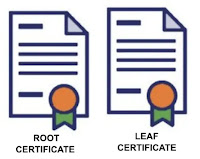Introduction:What are SSL/TLS Certificates?
What is certificate is another topic altogether. Please refer: What are SSL certs for understanding why digital certs are required.
secure communication over the internet. Understanding the different types of certificates is crucial for maintaining a robust security infrastructure. In this guide, we'll delve into the various types of SSL/TLS certificates, including root certificates, leaf certificates, CA certificates, and user certificates, providing valuable insights into their significance and functions.
SSL/TLS certificates are integral components of the public key infrastructure (PKI) that secure online communications. Below, we'll explore the key types of SSL/TLS certificates:
Root Certificate (Root CA Certificate):
Root certificates serve as the foundational trust anchors in the SSL/TLS certificate hierarchy.They are self-signed by trusted Certificate Authorities (CAs), establishing the ultimate trust in the certificate chain.
Root certificates are essential for validating the authenticity of subordinate certificates.
Intermediate Certificate (Intermediate CA Certificate):
Intermediate certificates bridge the gap between root certificates and end-entity certificates.They are issued by Root CAs and are used to facilitate the issuance and management of end-entity certificates.
Intermediate certificates play a crucial role in maintaining the integrity and security of the certificate chain.
Leaf Certificate (End-Entity Certificate):
Leaf certificates, also known as end-entity certificates, are issued to individual entities such as servers or users.These certificates contain public keys and entity information, serving as the endpoint for secure communication.
Leaf certificates are signed by intermediate certificates, establishing trust in the entity's identity and encryption capabilities.
Certificate Authority (CA) Certificate:
CA certificates are issued by trusted Certificate Authorities and are used to validate the authenticity of SSL/TLS certificates.They encompass both root and intermediate certificates, forming the backbone of the PKI infrastructure.
CA certificates play a pivotal role in maintaining trust and security in online transactions and communications.
User Certificate:
User certificates are issued to individual users for authentication, digital signatures, or encryption purposes.
These certificates contain the user's public key and identity information, enabling secure access to online services.
User certificates are commonly used in secure email communication, VPN access, and client authentication scenarios.


No comments:
Post a Comment